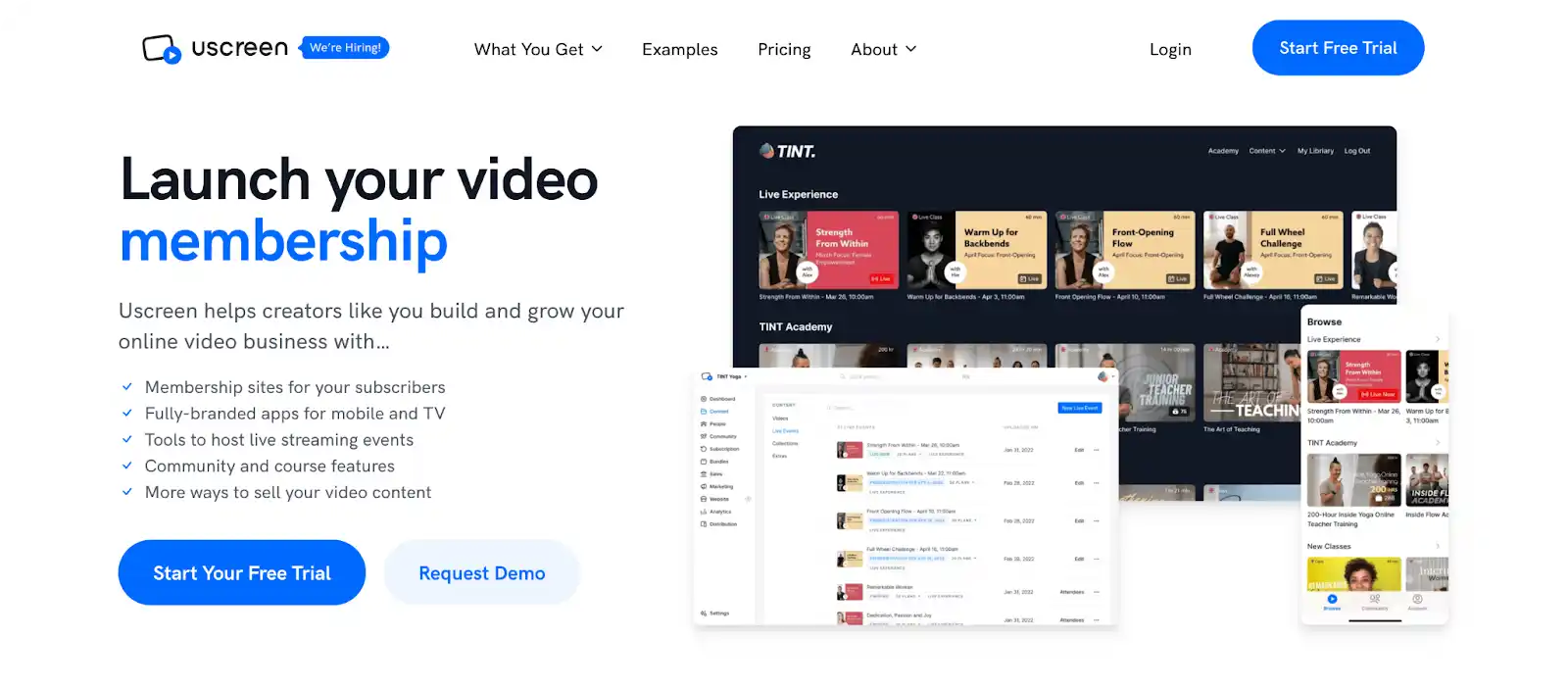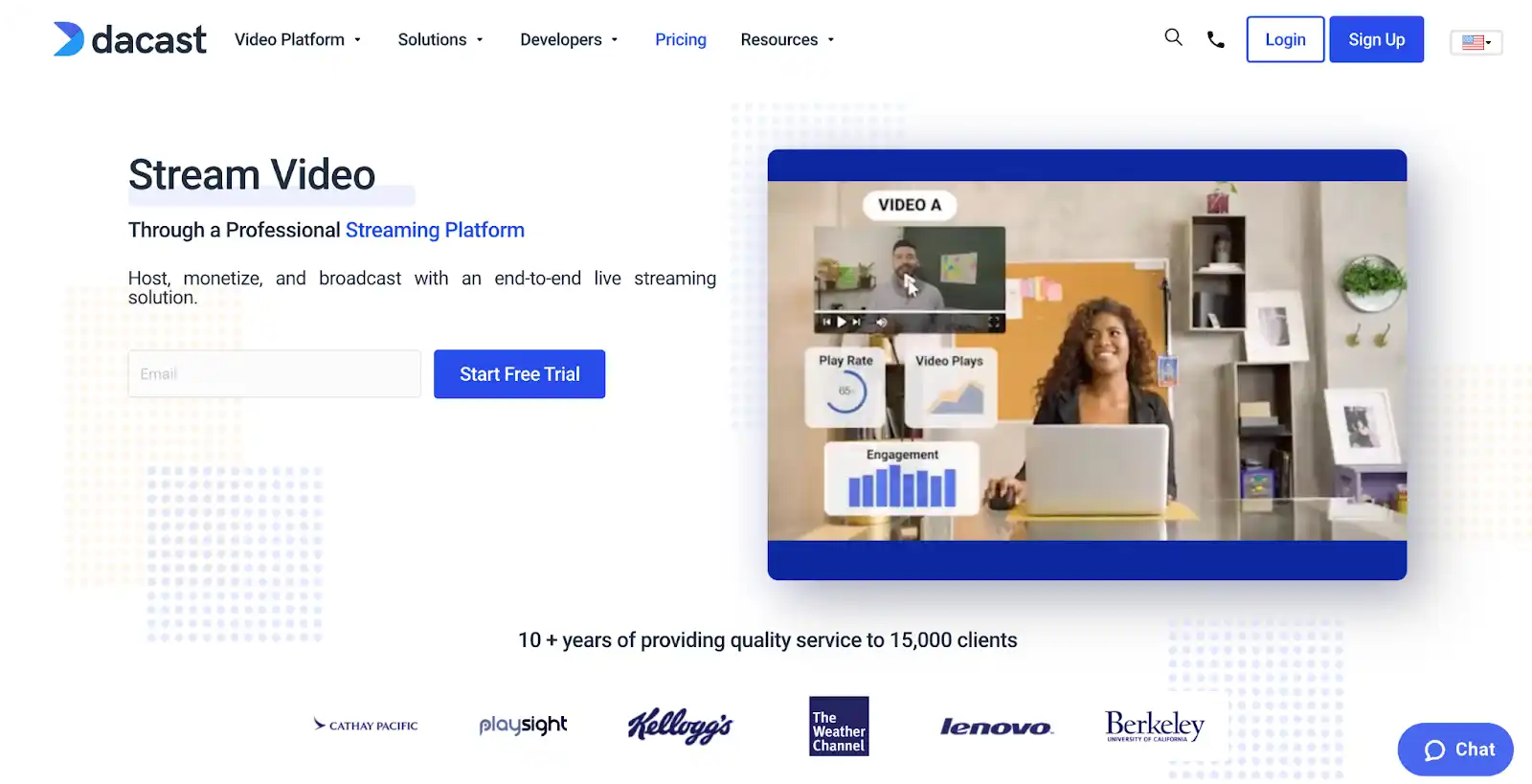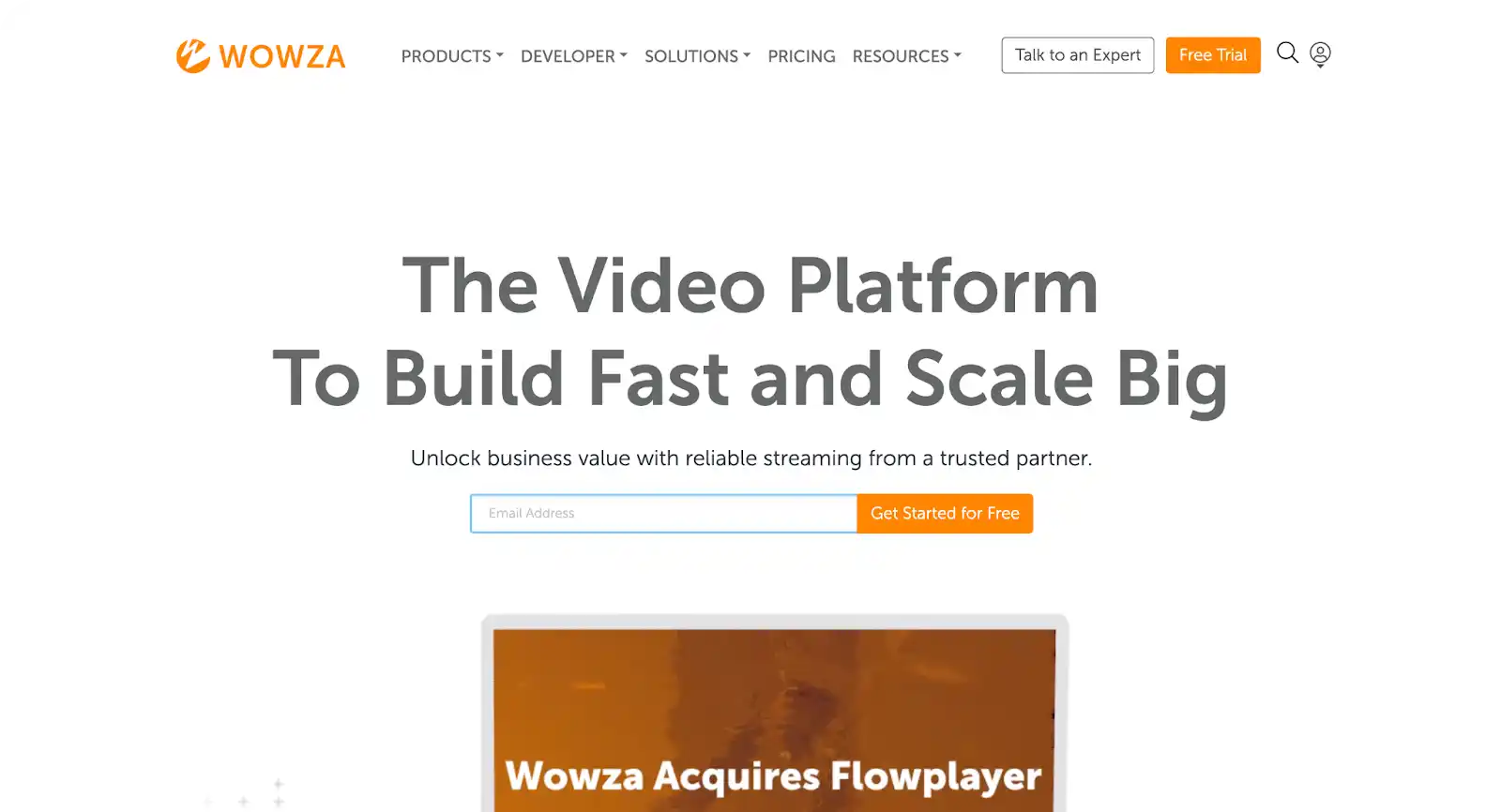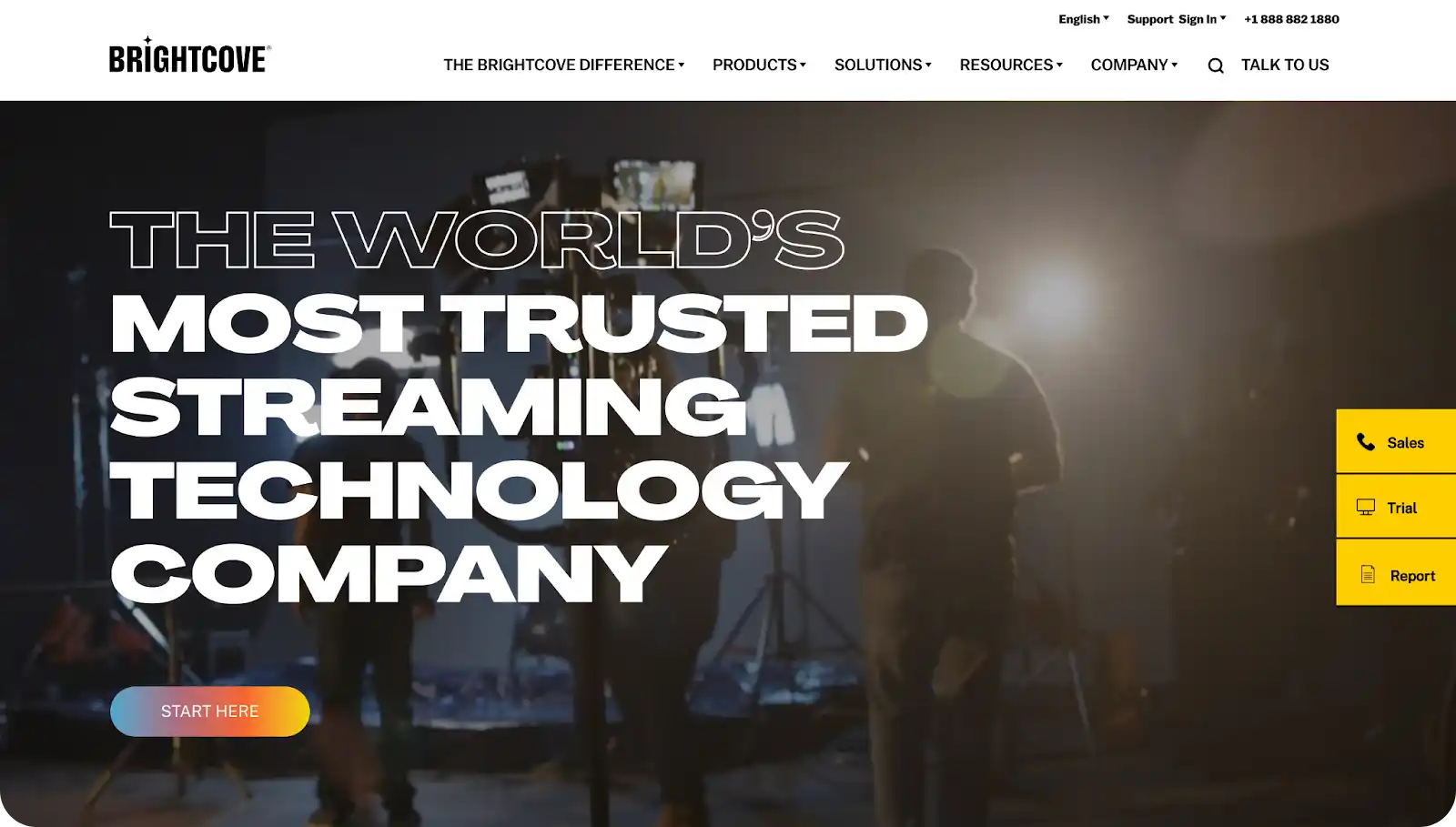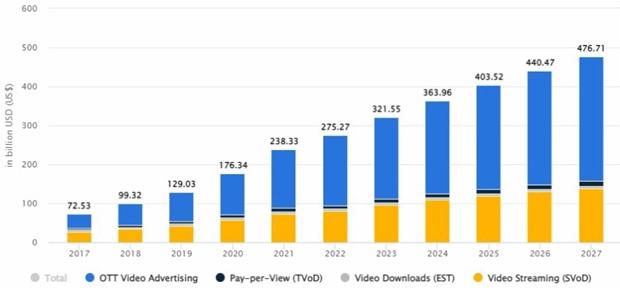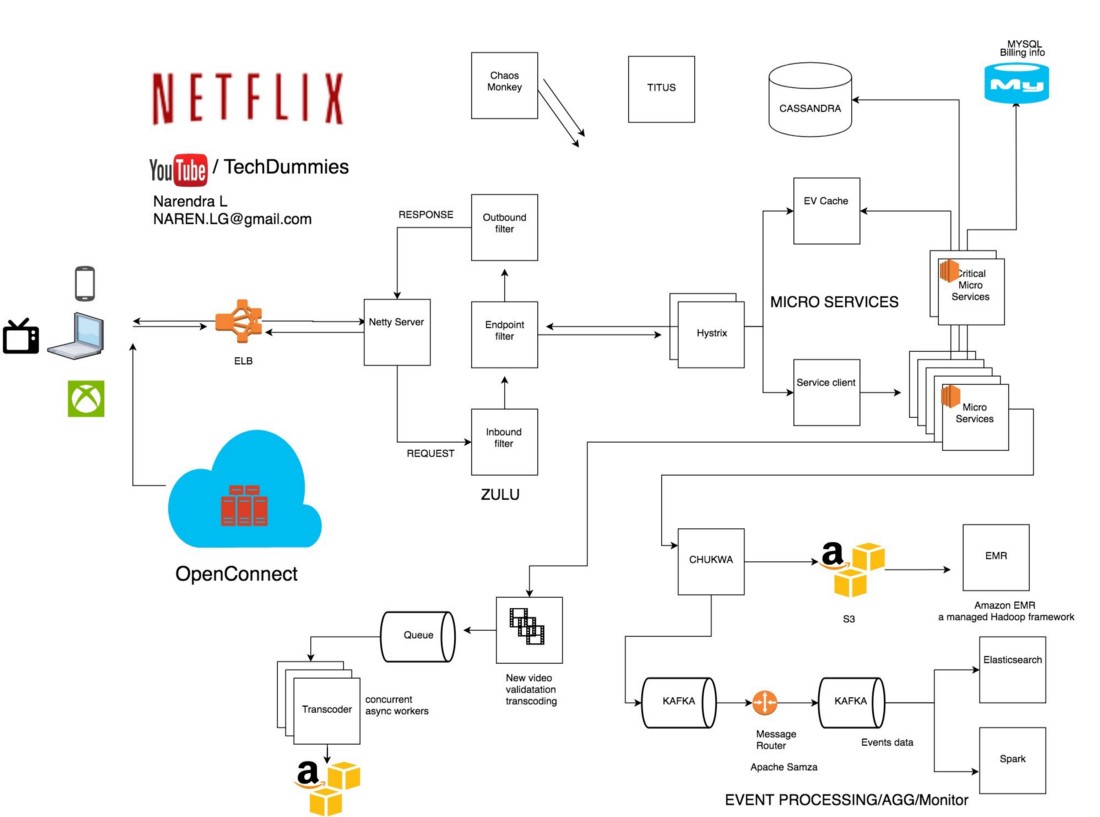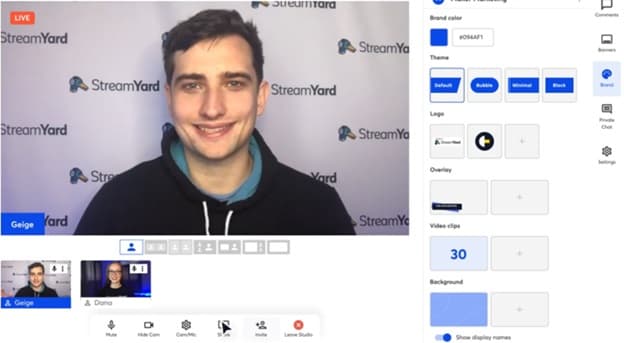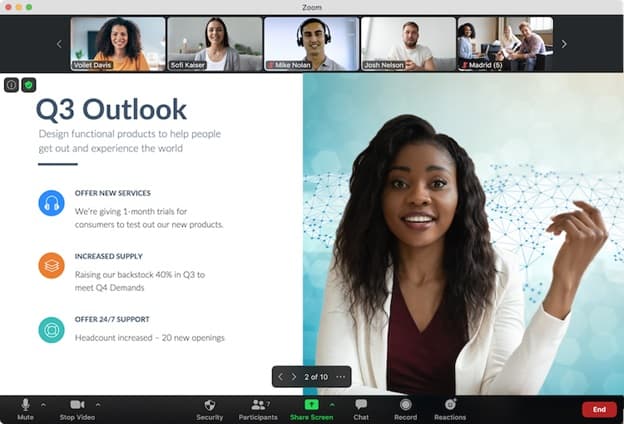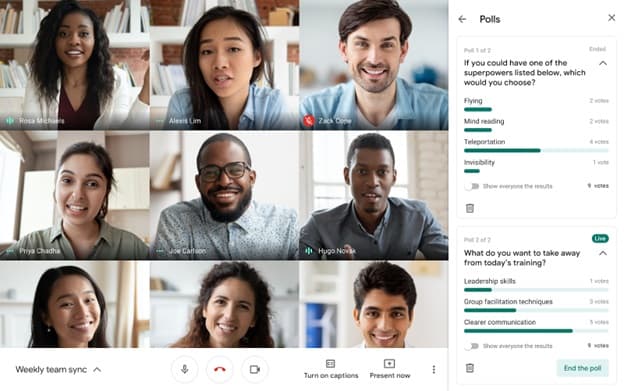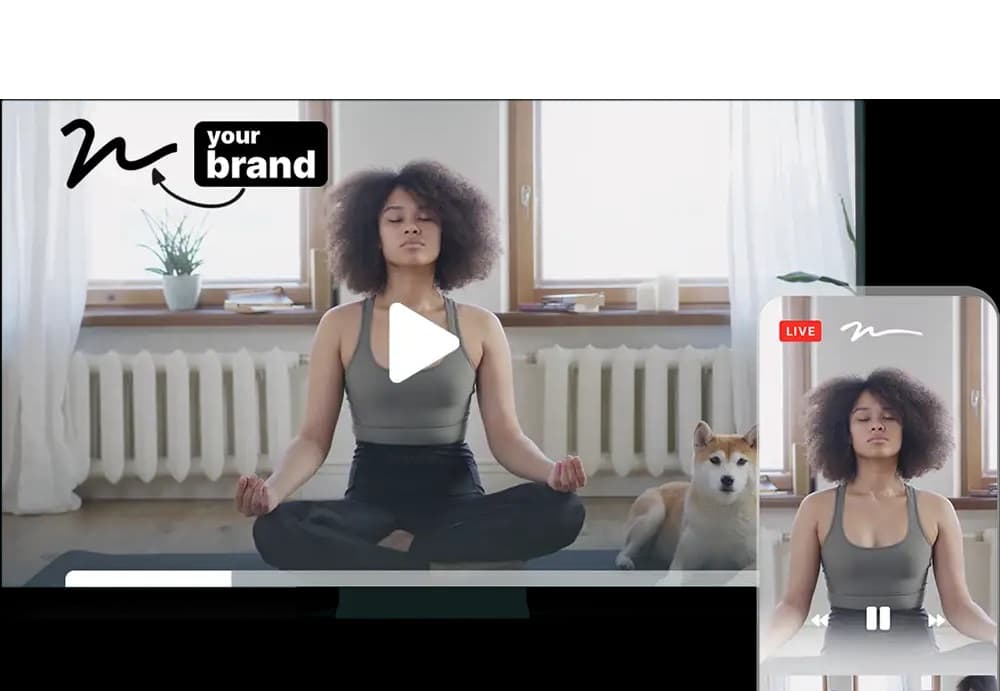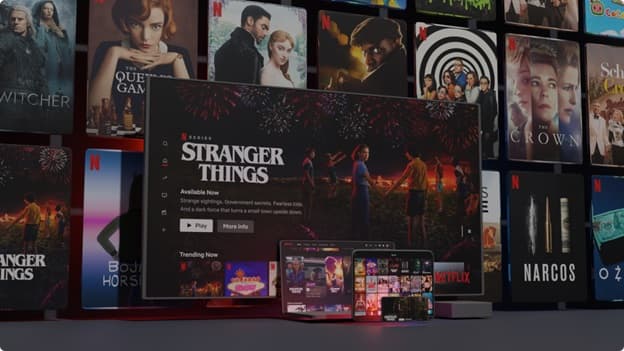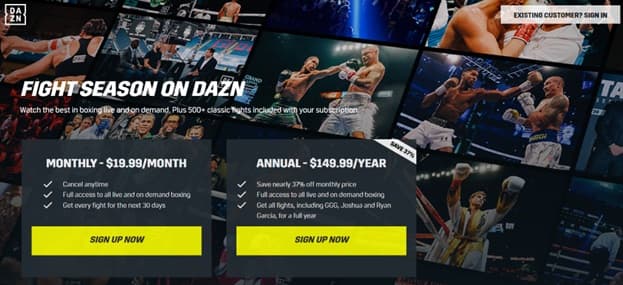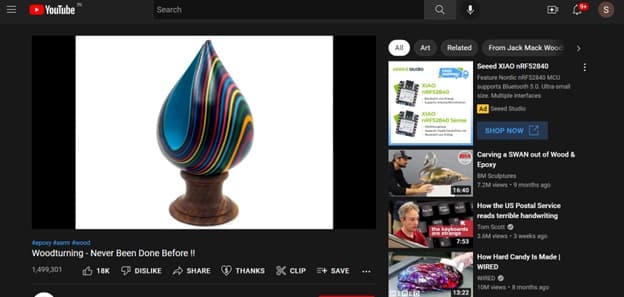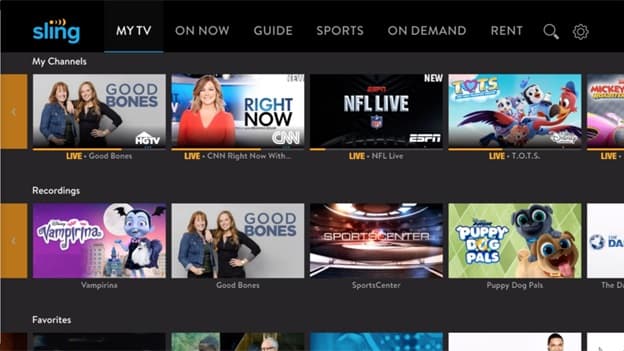The challenges and opportunities of launching an OTT platform
As the world of entertainment evolves, over-the-top (OTT) platforms have become a game-changing force in the media industry. They allow users to stream content to their devices without a traditional cable or satellite subscription. Simply put, OTT media is all about streaming content directly to viewers!
At Teyuto, we are passionate about the potential of OTT platforms and the opportunities they present.
In this blog, we will explore the challenges and opportunities of launching an OTT platform. We will also have a close look at the potential for growth and innovation in the OTT market.
So, whether you are a content creator, a media company, or a consumer of OTT services, this blog will provide invaluable insights into the ins and outs of launching an OTT platform. Let’s begin with the hard part first!
The challenges of launching an OTT platform
In theory, launching an OTT platform seems fairly simple. You can set up a website, purchase some video management software, and start uploading content. In reality, however, it is much more complex.

There are several challenges that you need to address for a successful OTT platform. For starters, the viewer wants a personalized experience. This can be in terms of suggested movies, TV shows, and other content to watch.
Then, there is the matter of subscriptions. How can you make the purchase process easier and more seamless? How can you make it so that the subscription renews automatically?
You also need to ensure that the platform is secure. You must protect the content from piracy, and at the same time, you need to ensure that the user’s data is safe.
All of this is while ensuring that your video content is as accessible as possible across all devices and platforms.
So, let's delve deeper into the major challenges you'll face while launching an OTT platform.
- The competitive landscape of the OTT industry
As the OTT industry continues to grow, the competition is becoming increasingly fierce. There are several top OTT platforms for consumers to choose from, including Netflix, Amazon Prime Video, Hulu, and Disney+ alongside others.
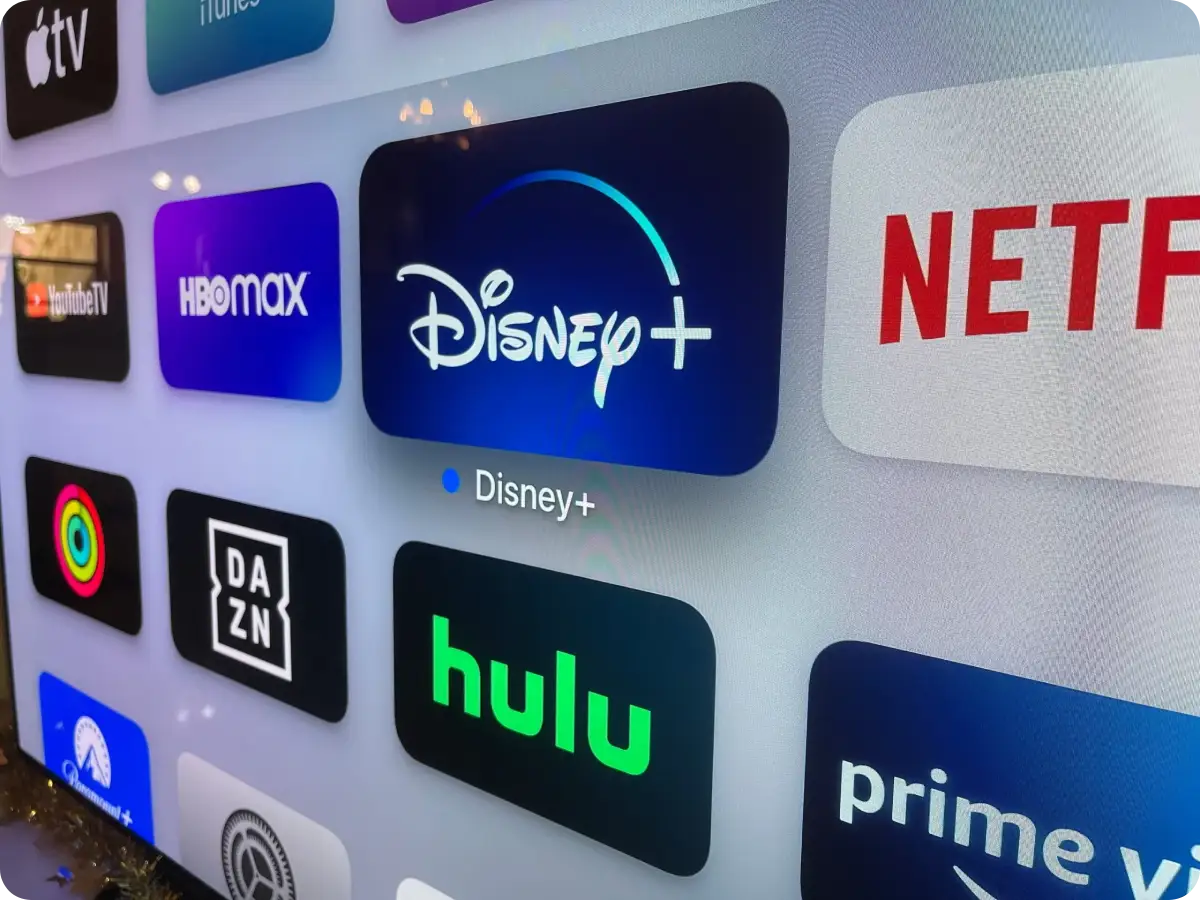
To stand out from the crowd, you need to offer something different. You need to offer something that isn’t already there. This could be in terms of content or the user experience.
Before you start working on your OTT platform, research the market thoroughly. Identify the gaps in the OTT industry, and think of how you can address those gaps.
- The cost and technical challenges
Building and maintaining an OTT platform requires significant financial investment and technical expertise.
From infrastructure and hosting costs to developing a user-friendly interface and ensuring smooth playback, the costs can quickly add up. But your users won't care about these costs.
They will only be bothered about how user-friendly and glitch-free the platform is. They will not think twice before leaving if they cannot resume a video on your OTT TV app after having watched a part of it on their smartphone.

To give a ballpark figure, the cost of building a high-quality OTT platform can range from tens of thousands to millions of dollars, depending on the scope and scale of the project. Additionally, OTT providers need to be prepared to invest in ongoing maintenance, R&D, and infrastructure upgrades to keep their platforms running smoothly and stay ahead of competitors.
However, you can minimize these costs by:
● Leveraging OTT solutions providers like Teyuto
● Developing a minimum viable product
● Outsourcing your development work
- Securing content and licensing agreements
The success of your OTT platform will be largely dependent upon your ability to secure content and licensing agreements. This is a particularly challenging task for new OTT platforms, as content creators are often reluctant to do business with unknown entities.
You will need to convince content creators and producers that your platform is a good fit for their content and that you will market it effectively. You will also need to negotiate licensing agreements and fees. This can involve securing rights for different regions and languages, as well as dealing with exclusivity clauses and other legal hurdles.
- Comprehensive video management
Managing large amounts of video content is a crucial part of operating an OTT platform. It requires a robust video content management system (video CMS) and a scalable OTT architecture that's compatible with all devices. Your platform needs to handle aspects like load balancing, uploading, transcoding, organizing content, gathering analytics, and reporting on viewership & engagement. This can involve multiple video management tools, licenses, and services, which can get difficult to manage and be expensive.
- User acquisition and retention
It's great to have a cool new OTT platform. But you need people to use it. For this reason, user acquisition is a top priority, especially for new OTT platforms.
You must create a marketing strategy that will attract new users and encourage them to sign up for your platform. You’ll have to generate coupons, gift cards, and other promotions.

You also need to work on user retention. You’ll have to know and avoid abandoned carts, drive reselling campaigns, and even push cross-sells to your viewers. You must further engage your users with rich features like live comments, in-video polls, in-video CTAs, and so on.
- Staying ahead of changing technology and consumer preferences
Consumer preferences change, and they change fast! The rise of streaming services (and the decline in linear TV viewership) is a prime example of it. So, consumer-centric innovations and content addition should not be an afterthought.
Today, the OTT TV industry is evolving rapidly, with new technologies and platforms emerging on a regular basis. This makes it all the more important to stay on top of trends and ensure that your platform always has an edge.

You may need to invest in ultra-low-latency streaming, Artificial Intelligence, or other technologies down the line.
Although launching an OTT platform is no easy task, the pros of launching an OTT solution clearly outweigh the cons. So, now, let’s take a look at some of the most promising OTT opportunities in the segment.
The opportunities in launching an OTT platform
OTT offers innumerable opportunities to content creators, media companies, and consumers. Let’s take a look at some of the most exciting opportunities in the OTT industry.
- The potential for growth in the OTT industry
As more people cut the cord and turn to streaming services, there is an ever-growing need for new OTT platforms.
According to Statista, the revenue in the OTT video segment could’ve already reached $275.3 billion in 2022. By 2027, this figure is expected to be $476.7 billion. Owning just a small pie of this growing market can lead to millions of dollars in revenue, even if you’re starting from scratch.
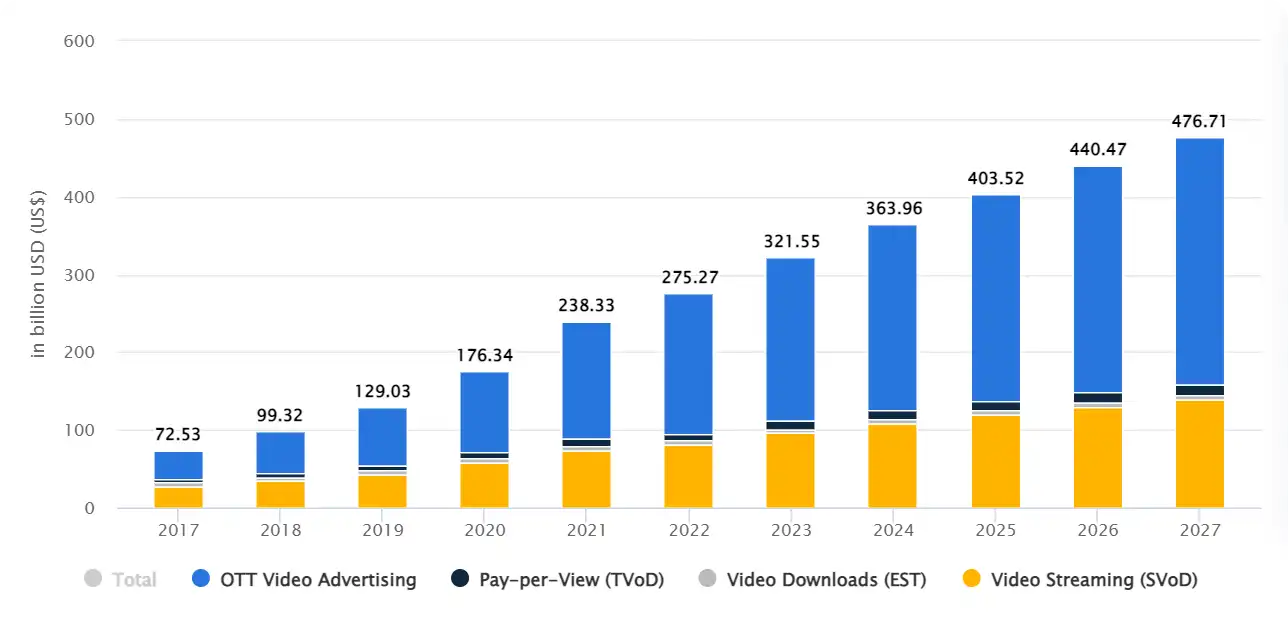
Also, there’s a growing demand for original and niche content, which can be a good entry point for new OTT platforms.
- The ability to reach a global audience
One of the biggest benefits of launching an OTT platform is the ability to reach a global audience. With an OTT service, you can reach viewers all over the world, something that's not possible via traditional TV networks.

The burgeoning market for localized content also means that new OTT platforms can create content that is tailored to specific regions and languages.
The demand for such services is only increasing. By offering tailored content for specific regions and languages, you can stand out in a crowded industry and give your audience exactly what they want.
- Flexible Monetization
You can monetize your OTT platform however you want. There are several ways to monetize OTT content, from Subscription VOD (SVOD) and Transactional VOD (TVOD) to advertising (AVOD), paid promotions, and hybrid monetization.
Generally, new OTT services offer a "freemium" model, which is a hybrid monetization strategy that allows users to access basic content for free and pay for premium content.

This approach is a great way to get new users hooked on your platform. Once they're hooked, they will be willing to pay sooner or later.
Another approach is to partner with advertisers. This could involve having an ad at the beginning of a video or including ads within the video itself, even if you’re live streaming (using VAST technology).
- Robust analytics and user engagement
For great results, you need to have a strong understanding of your users. That's precisely where analytics comes in.
Analytics tools provide valuable insights into how users are interacting with your content, so you can make data-driven decisions about what to publish on your platform.
Additionally, you can use these tools to understand how your users are engaging with each other. What are they saying about your platform? Analytics tools can also help you understand where your users are coming from, or how they found your platform in the first place.

Now, having a strong understanding of your users is only half the battle. The other half is keeping them engaged. Backed by these insights, a major opportunity area for you is to uniquely engage users.
Perhaps, you can set up a workflow automation every time a user makes a purchase. Or, send emails and push notifications to update them about a video they may be interested in.
- Unique and exclusive content
Unique and exclusive content is the need of the hour. That's why you can see leading OTT platforms investing their resources in creating original content. The only thing is they can't create content around everything! It sets your OTT platform's original content apart from them.
The OTT industry has brought a few tectonic shifts within the global entertainment landscape. First, it has lowered the barrier to entry for content creators. Second, it has increased the appetite for quality and original content globally.
So, if you think that you can quench this global thirst, the world is your oyster.
- The potential for partnerships and collaborations with other industry players
As the OTT industry continues to grow, so does the need for collaboration. By partnering with other OTT platforms, you can expand your reach and offer a more diverse selection of content to your users.
In addition to collaboration, there is also an opportunity for video OTT platforms to partner with other industries. This could lead to a win-win scenario where collaborating players can tap into each other’s advantages.
Now that we’ve understood the pitfalls and the opportunities of OTT platforms, let’s find out how Teyuto can help you realize your dream – with a simple touch of a button.
How Teyuto can help launch your OTT platform?
As we know, the world of OTT services is complex and constantly changing. For this reason, it can be difficult to get it off the ground.
Fortunately, there are companies like Teyuto that specialize in helping OTT entrepreneurs launch their platforms and overcome the challenges they face.
Here are some of the ways that Teyuto can help you launch your OTT platform.
- Create and launch your powerful OTT platform
Teyuto is a global OTT solutions provider that specializes in building and launching OTT platforms. You can launch your OTT service in minutes using Teyuto’s no-code, drag-and-drop platform builder.
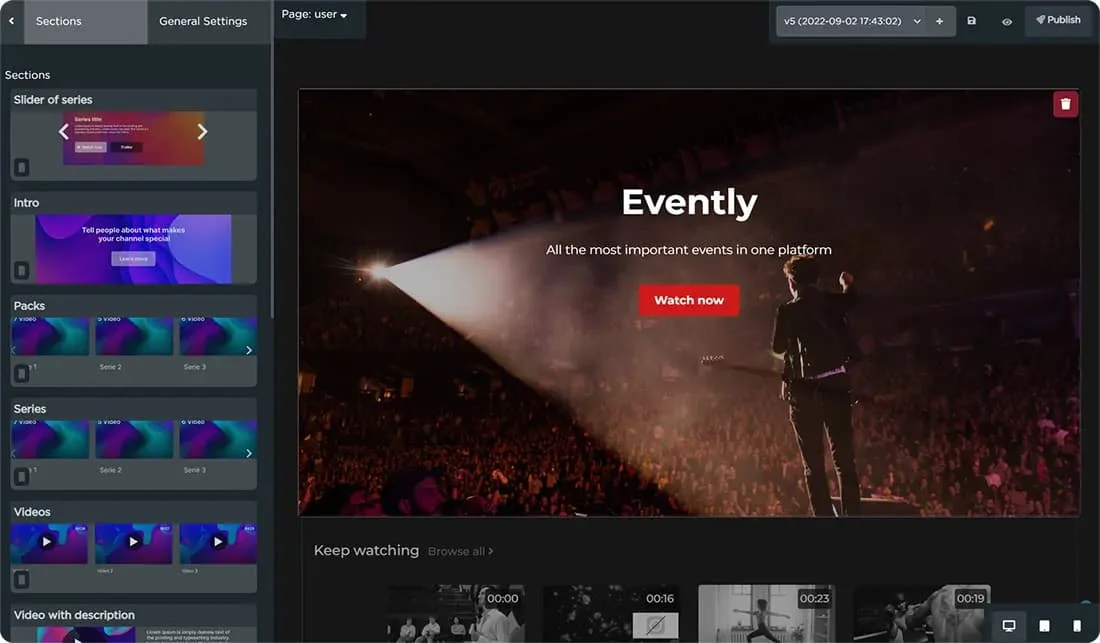
Deemed the best OTT provider, it helps you design and build a fully-customized, white-label OTT platform from scratch. Moreover, it also supports you to publish and maintain your OTT app. Teyuto has expertise in building powerful Mobile OTT Apps, TV OTT Apps, and web-based OTT platforms.
- Feature-intensive yet Cost-effective
Despite being a category leader, Teyuto is the most cost-effective OTT service provider out there. Its plans start at just €29 per month! With Teyuto, you won’t have to spend several thousand or millions of dollars, even if you’re building a high-performance OTT platform.
Teyuto also provides a 14-day free trial. So, you can test the platform before you buy.
- Monetize your OTT platform
Teyuto helps you monetize your OTT platform by providing a range of monetization options. These include Subscription VOD (SVOD), Transactional VOD (TVOD), and advertising (AVOD). Unlike other revenue share OTT builders, Teyuto doesn’t charge you anything for your user payments and subscriptions. So, you can reinvest that money in your business and grow at a faster pace.
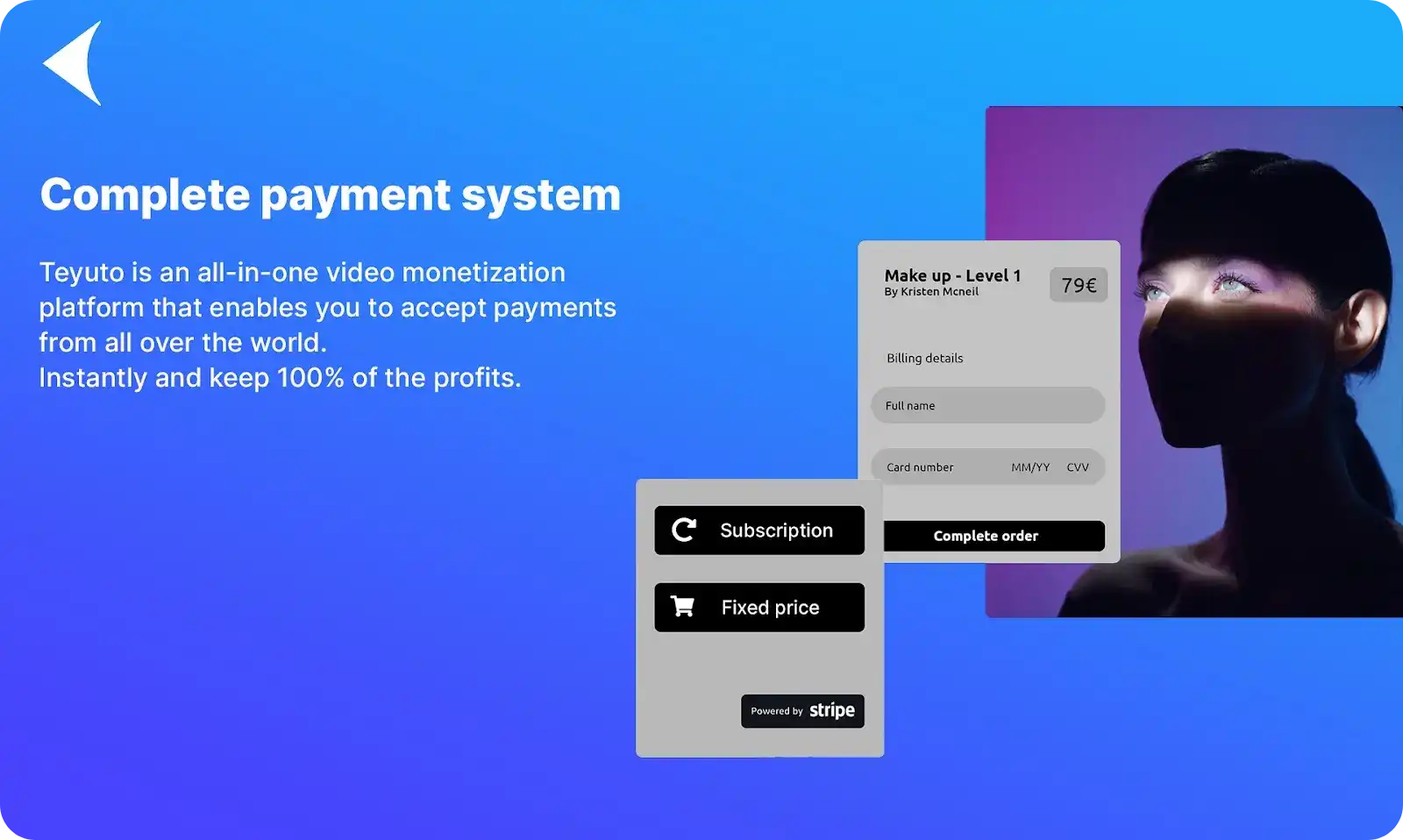
- Offer the best video search engine
A video search engine is the heart and soul of any OTT service. The challenge is that most of the solutions providers extend tag-based searches. This approach often returns no results when the "keyword" isn’t an exact match.
However, Teyuto's search engine will allow your viewers find exactly what they're looking for, leading to a seamless platform experience. It also has a great recommendation engine that can recommend series and packages to your users based on their usage patterns.
- Seamless user experience
Teyuto's goal is to help you provide a seamless user experience to you and your viewers. One way it does this is through its Content Management Solution (CMS), which makes it easy to manage all of your content in one place. It also includes features like bulk uploading, auto recording (live streaming videos to VOD), organizing content as Collection, Series, and Packages, and a whole lot more!
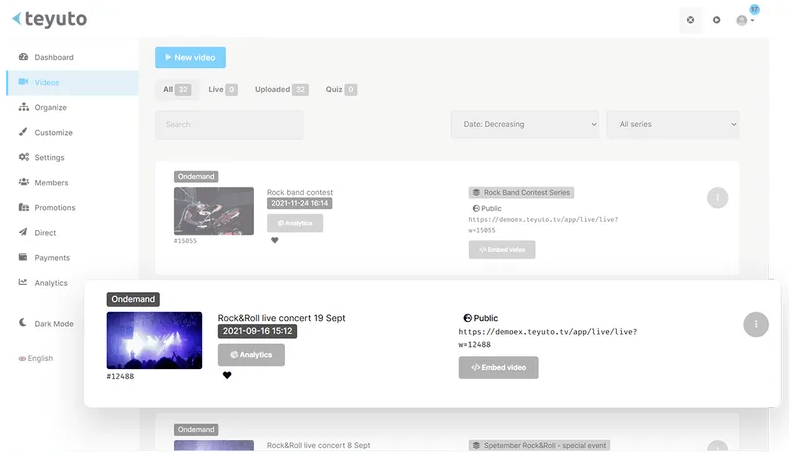
Teyuto also enables you to improve your OTT platform by providing robust analytics and data. Its analytics features include watch time, number of plays, video views, top series and videos, and other detailed statistics. It also integrates with Google Tag Manager and Google Analytics to provide even more data about your OTT platform. Ultimately, all of this helps you make informed decisions for your platform's constant evolution.
- Protect your content and users
At Teyuto, the safety of your content and viewers is one of the top priorities. The OTT solution provider extends a secure and reliable OTT platform with highly encrypted videos and signed URLs that prevent any unauthorized access. Teyuto also offers two-factor authentication on all of its plans. Other security features of Teyuto include simultaneous login sharing protection, geoblocking, malicious bot detection and removal, and SSL encryption.
- Grow your OTT platform
Teyuto provides a wide range of marketing and engagement features to grow your OTT platform. These include unlimited coupons, unlimited gift cards, integrations with email marketing, and abandoned cart lists to name a few. On top of that, it also offers eCommerce integrations both in video and video players.
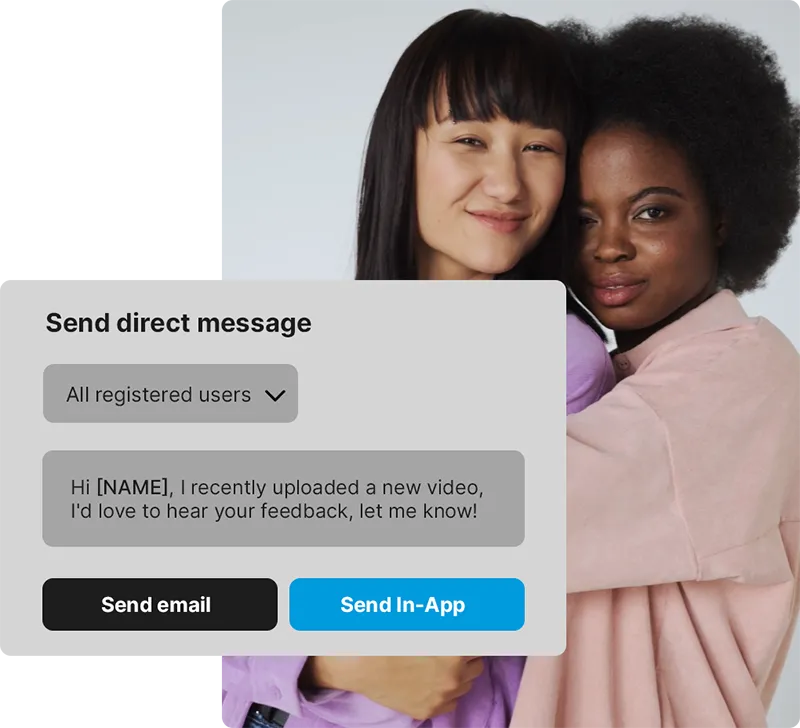
- 24/7 support
Teyuto wants you to thrive! And, for it, it provides 24/7 support including email support, live chat support, and 1-on-1 onboarding calls. Its customer support team is highly experienced and trained to help you with any issues you have. On certain plans, you also get a dedicated account manager to help you with any questions you have.
- Integrate with other applications
Through its API and Zapier integration, Teyuto allows you to integrate with other applications. The platform also provides webhooks for custom integrations. As an added advantage, its integration with Zapier not only helps you automate workflow processes but also connects these automated workflows with other popular apps like Mailchimp, Facebook, Hubspot, Google Sheets, Gmail, and 5000+ other platforms.
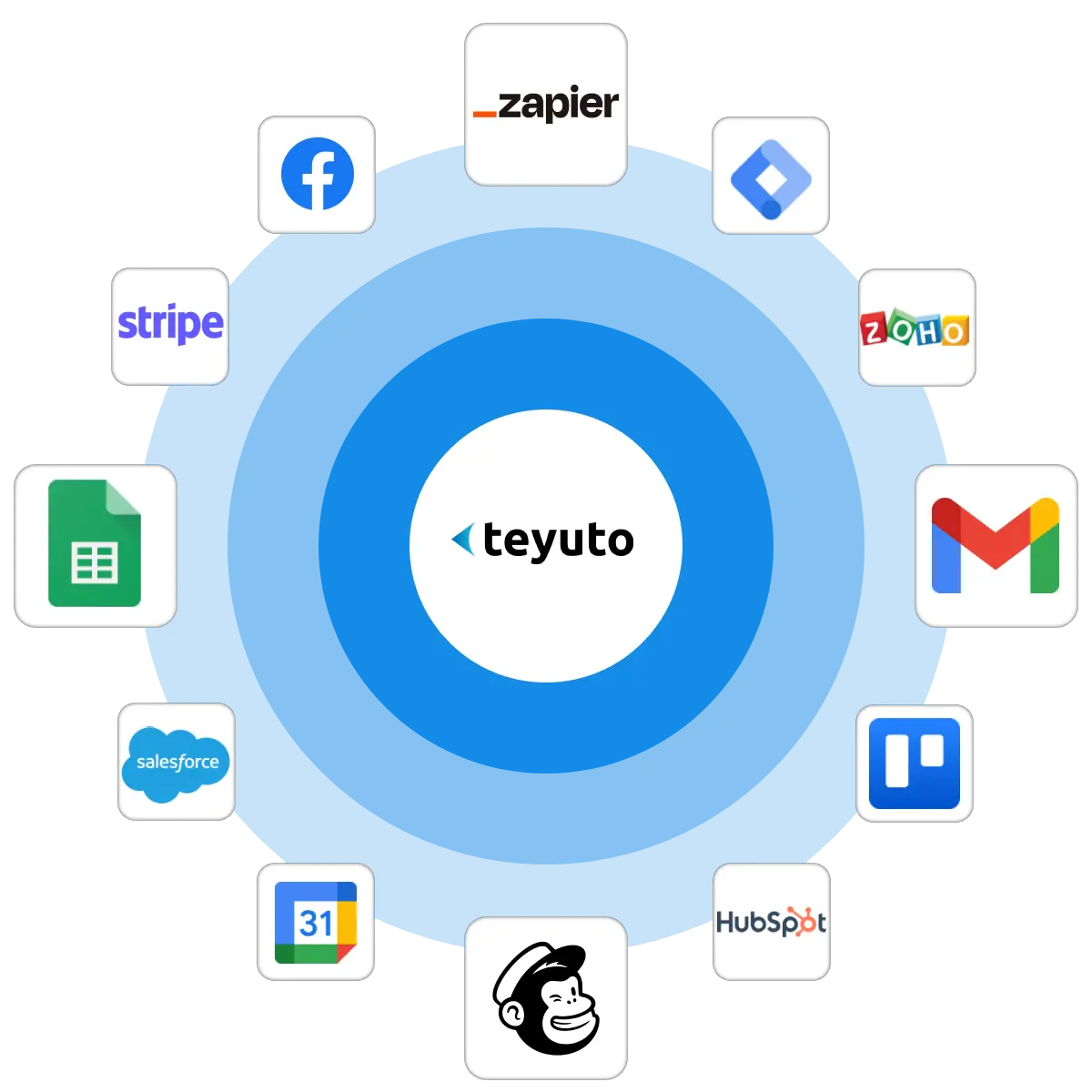
- Stay at the top of Innovation
Lastly, and most importantly, Teyuto always remains at the edge of innovation in the OTT industry. This means that you get all the latest features, innovations, and best practices to offer the best possible user experiences. In other words, your OTT platform is always ahead of the curve and ready for whatever the future may bring without ever having to worry about R&D or development costs.
Final Words
Disrupting the status quo, OTT platforms are game-changers in the media industry.
The competition is fierce. The growth is rapid. A lot of challenges have to be overcome. Many opportunities to be seized.
The time to act is now.
If you’re interested in launching an OTT platform, Teyuto is here to help. Get in touch with us if you have any queries or sign up for our 14-day free trial today. Godspeed!


